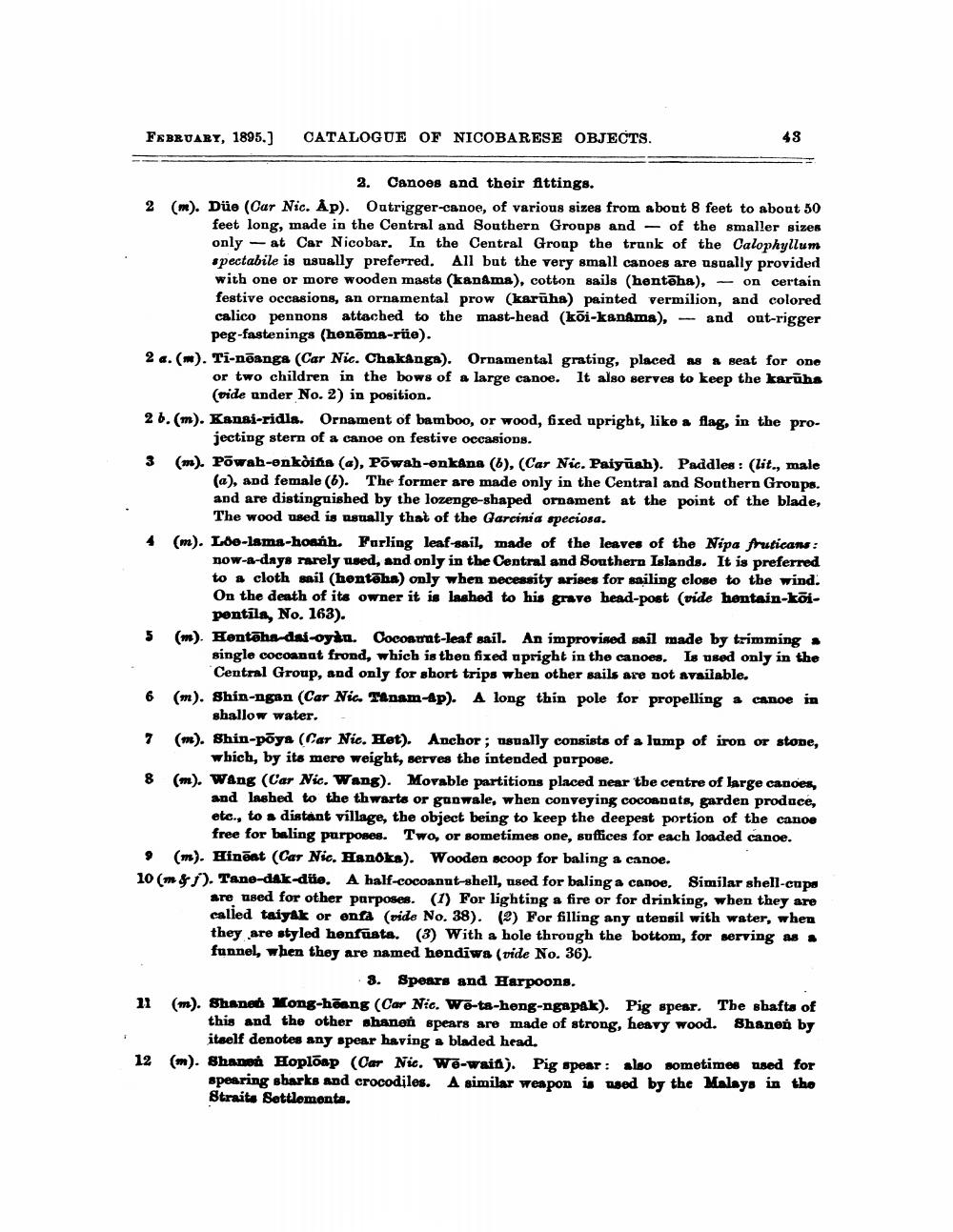________________
FEBRUARY, 1895.)
CATALOGUE OF NICOBARESE OBJECTS.
48
2. Canoes and their fittings. 2 (m). Düe (Oar Nic. Ap). Outrigger-canoe, of various sizes from about 8 feet to about 50
feet long, made in the Central and Southern Groops and of the smaller sizes only - at Car Nicobar. In the Central Group the trunk of the Calophyllum spectabile is usually preferred. All but the very small canoes are usually provided with one or more wooden masts (kanama), cotton sails (hontöha), - on certain festive occasions, an ornamental prow (karūha) painted vermilion, and colored calico pennons attached to the mast-head (kõi-kanama), and out-rigger
peg-fastenings (honāms-rüe). 2 a. (). Ti-nõanga (Car Nic. Chakanga). Ornamental grating, placed as a seat for one
or two children in the bows of a large canoe. It also serves to keep the karūhs
(vide under No. 2) in position. 26.(m). Kansi-ridla. Ornament of bamboo, or wood, fixed upright, like a flag, in the pro
jecting stern of a canoe on festive occasions. 3 (m). Powah-enkdins (a), Powah-enkána (6), (Car Nic. Paiyah). Paddles : (lit., male
(a), and female (6). The former are made only in the Central and Southern Groups. and are distinguished by the lozenge-shaped ornament at the point of the blade,
The wood used is usually that of the Garcinia speciosa. A (m). Lo-lama-honńh. Farling leaf-sail, made of the leaves of the Nipa fruticans:
now-a-days rarely used, and only in the Central and Southern Islands. It is preferred to a cloth sail (hontāba) only when necessity arises for sailing close to the wind. On the death of its owner it is lashed to his grave head-post (vide bontain-koi
pentila, No. 163). 5 m). Kontaho-dni-oyku. Cocontat-leaf sail. An improvined sail made by trimming
single cocoanat frond, which is then fixed upright in the canoes. Is used only in the
Central Group, and only for short trips when other sails are not available. 6 (m). Shin-ngan (Car Nic. Menam-&p). A long thin pole for propelling a canoe in
shallow water, (m). Shin-põya (Car Nic. Het). Anchor ; usually consists of a lump of iron or stone,
which, by its mere weight, serves the intended porpose. (m). Wang (Car Nic. Wang). Morable partitions placed near the centre of large canoes,
and lashed to the thwarts or ganwale, when conveying cocoanats, garden produce, etc., to a distant village, the object being to keep the deepest portion of the canoe
free for baling purposes. Two, or sometimes one, suffices for each loaded canoe. 9 (m). Hināat (Car Nic. Handka). Wooden scoop for baling a canoe. 10 m 81). Tane-dak-düe. A half-cocoanut-shell, used for baling a canoe, Similar shell-caps
are tused for other purposes. (1) For lighting a fire or for drinking, when they are called taiyak or onfa (vide No. 38). (2) For filling any utensil with water, when they are styled henfusta. (3) With a hole through the bottom, for serving as . funnel, when they are named hendiwa (vide No. 36).
3. Spears and Harpoons. 11 (m). Shane Hong-hoang (Car Nic. We-te-hong-ngapak). Pig spear. The shafts of
this and the other shanon spears are made of strong, heavy wood. Shanon by
itself denotes any spear having a bladed head. 12 (m). Shanon Hoplõap (Car Nic. Wa-wain). Pig spear: also sometimes used for
spearing sharks and crocodiles. A similar weapon is used by the Malays in the Straits Settlomonts.




